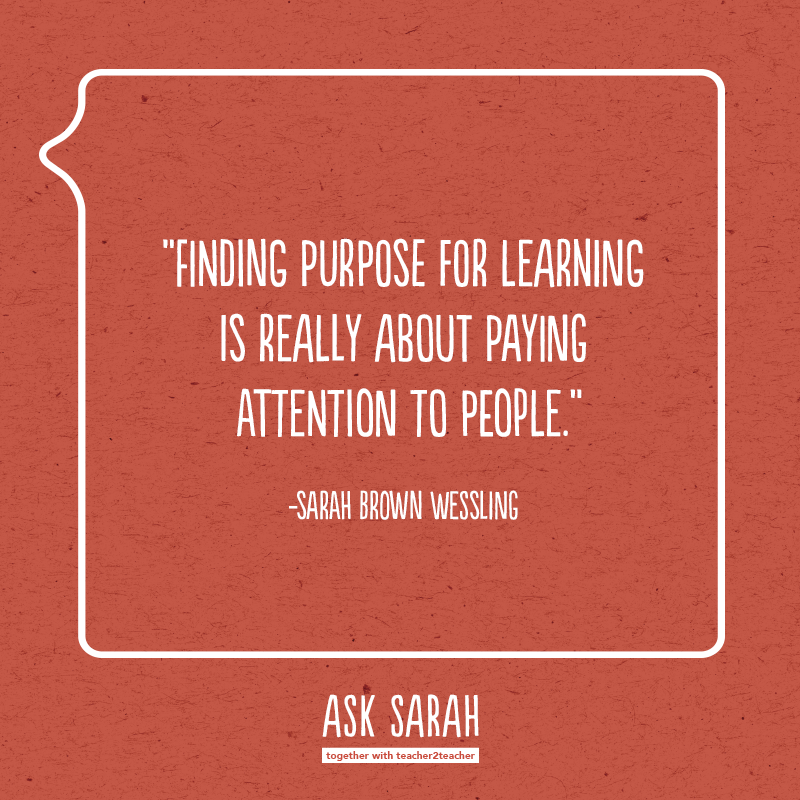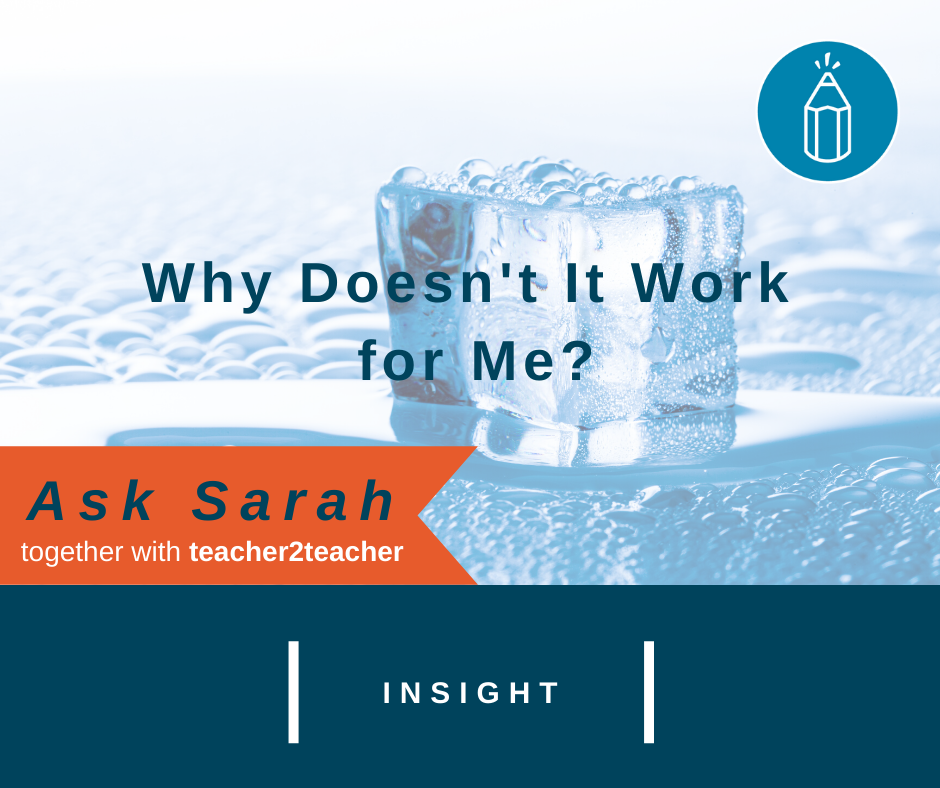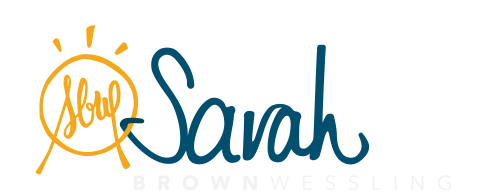

I’ve watched many of your videos at the Teaching Channel and love them. But how come the students are always so well-behaved and on task? I have tried the same strategies, but most of the time they just talk or are off-task. What am I doing wrong?
Sincerely,
Why Doesn’t It Work for Me?
If you’ve never heard yourself asking this question, you might not be a real teacher. Hasn’t this happened to every single one of us? We read about it, hear about it or even see it in action and try to record every single move in our minds (or through copious notes) and we rush to our classrooms only to discover that didn’t work for me!
Of course, there are probably just as many of the opposite examples. You know the ones. With a little trepidation and a whole lot of hopefulness we leap into something new and the pieces place like bits of little magic.
These are the extremes. But we actually spend most of our teaching time, living the reality that lies in-between these two separate points: the struggle. It’s sounds horrible doesn’t it? The struggle. But it’s the most real work we do. And we don’t have to evade it because it also carries creative solutions, unexpected clarity and a little bit of everyday magic. It also holds the answer to your question about why that strategy didn’t work for you: you hadn’t made it your own yet.
Think of it like the difference between musicians who cover songs with the intent of sounding as close to the original as possible and the ones who cover songs and end up giving their listeners a whole new experience. The strategies are important, but they come alive when we closely understand the people in our classrooms and are in-tune with a purpose for learning that matches their needs.
Here are a few things you can do to rely less on collecting strategies and become more strategic.
- Think about the strategy, not as an isolated task or protocol, but as part of the larger vision for learning you’ve already established.
- Keep engaging in the complicated work of finding the real learning purpose of the lesson. Ask yourself what you want your students to learn today. Not what they’re going to do today.
- Continue reading each student’s learning story. What does Olivia need today? How does she best learn? What about this strategy will work for her and what will you need to revise?
- If your students seem off-task and unengaged, it may be because they see this as a strategy, as a task, as something to get through instead of something to learn from. Be sure you’ve told them over and over why they are using this strategy and make sure your reason is real to them. (Remember, “because it’s on the test”, doesn’t count. That’s still an extrinsic reason.)
When you take on these tough components of planning and teaching — congratulations — it means you’re struggling and you know that finding purpose for learning is really about paying attention to people.
Teach openly,
With Teacher2Teacher




How do we pose a question or ask for help in the teacher2teacher community?
Hi Art,
You can actually submit it right from this website. This link should get you there! https://sarahbrownwessling.com/contact-ask-sarah/ Let me know if you have any difficulties. Looking forward to hearing your question.
Sarah
In addition to the projects that are building such systems for Bitcoin, we are seeing a lot of interest in using Cosmos for bringing DeFi to other assets such as Kava Labs. If these efforts deemed successful, barriers for Bitcoin use in DeFi would significantly diminish. Success in this regard is to be able to attract sufficient liquidity to the peg zone and to maintain a reasonable level of decentralization by attracting a large enough number of validators. However, since the launch of the DeFi on Bitcoin, conversions to other assets become unnecessary, and BTC coins can be used natively on these Bitcoin-based DeFi platforms. Through Clarity, developers can deploy smart contracts on top of Bitcoin without changing Bitcoin’s scripting language or Bitcoin’s decentralization. Importantly, Stacks’ smart contracts can interact with Bitcoin’s global state and on-chain data, meaning you can create DeFi apps that react to native Bitcoin transactions.
https://www.lits.co.kr/lits/bbs/board.php?bo_table=free&wr_id=98703
It’s important to remember that crypto is largely unregulated in the UK, so it is highly unlikely you will be covered by the Financial Services Compensation Scheme, so you should not expect any kind of compensation to cover any form of crypto-related losses. Departments, agencies and public bodies Save the Children US accept cryptocurrency donations directly through our crypto donation page, powered by Gemini and The Giving Block. Donations are immediately sold and converted to US Dollars. We do this so that we can operationalize your donations to have immediate impact for the families and children we serve. Detailed information about Crypto DeFi Wallet – onboarding, wallet management, deposit and withdrawal At its simplest, DLT is a system for storing and managing information distributed across participants in a network. The type of DLT cryptoassets typically use is called a blockchain because the information is stored in blocks linked by cryptographic (basically complex mathematical processes) techniques. This keeps data secure for storage and or transmission.
http://interpharm.pro/# online pharmacy india
best website to buy prescription drugs – interpharm.pro A gem in our community.
farmacie on line spedizione gratuita farmacia online farmacia online miglior prezzo
https://pharmacieenligne.icu/# Pharmacie en ligne fiable
https://onlineapotheke.tech/# online apotheke deutschland
http://farmaciaonline.men/# comprare farmaci online all’estero
http://esfarmacia.men/# farmacia online internacional
http://edapotheke.store/# internet apotheke
acheter sildenafil 100mg sans ordonnance
https://edapotheke.store/# online apotheke gГјnstig
Online medicine home delivery: Online medicine home delivery – india pharmacy
best online pharmacy india: top online pharmacy india – indian pharmacy online
A global name with a reputation for excellence. purple pharmacy mexico price list: medication from mexico pharmacy – purple pharmacy mexico price list
india pharmacy: indian pharmacy paypal – pharmacy website india
best mail order pharmacy canada: canadian discount pharmacy – canadian pharmacy world reviews
canadian pharmacy: maple leaf pharmacy in canada – canadian pharmacy prices
Efficient, reliable, and internationally acclaimed. online shopping pharmacy india: cheapest online pharmacy india – canadian pharmacy india
buying prescription drugs in mexico online: buying from online mexican pharmacy – mexican pharmaceuticals online
best rated canadian pharmacy: canadian pharmacy sarasota – canadian king pharmacy
Appreciate their commitment to maintaining global healthcare standards. buy prescription drugs from india: cheapest online pharmacy india – india online pharmacy
buy prescription drugs from india: world pharmacy india – india pharmacy mail order
Top 100 Searched Drugs. top 10 online pharmacy in india: top 10 pharmacies in india – reputable indian online pharmacy
Always up-to-date with the latest healthcare trends. zithromax buy online: buy Z-Pak online – buy cheap zithromax online
They stock quality medications from all over the world. http://edpillsotc.store/# ed treatments
Their health awareness campaigns are so informative. http://azithromycinotc.store/# zithromax prescription
Their staff is so knowledgeable and friendly. https://doxycyclineotc.store/# cost of doxycycline tablets
I’m always impressed with their efficient system. http://edpillsotc.store/# mens erection pills
doxycycline 100mg generic buy doxycycline over the counter doxy 200
best online pharmacy india best Indian pharmacy top 10 pharmacies in india
This pharmacy has a wonderful community feel. https://mexicanpharmacy.site/# mexican pharmaceuticals online
Get information now. https://drugsotc.pro/# pharmacy discount card
The go-to place for all my healthcare needs. https://mexicanpharmacy.site/# mexican pharmaceuticals online
Consistent excellence across continents. http://drugsotc.pro/# canadian pharmacy drugs online
mail order pharmacy india [url=http://indianpharmacy.life/#]cheapest online pharmacy[/url] п»їlegitimate online pharmacies india
top 10 pharmacies in india buy medicines from India indianpharmacy com
buying drugs online no prescription: buy from canadian pharmacy – rx meds online
prescription price for neurontin: neurontin 3 – neurontin 50mg cost
They maintain a high standard of hygiene and cleanliness. http://gabapentin.world/# neurontin 150 mg
mexican rx online or mexico pharmacy online – buying prescription drugs in mexico online
mexican drugstore online : mexican pharmacies – buying prescription drugs in mexico online
mexico drug stores pharmacies : mexican pharmacies – buying prescription drugs in mexico
purple pharmacy mexico price list : mexico online pharmacy – mexico pharmacies prescription drugs
reputable mexican pharmacies online – buying prescription drugs in mexico online – mexican drugstore online
https://stromectol24.pro/# minocycline 100 mg over the counter
pharmacy website india: buy medicines online in india – indian pharmacies safe
https://stromectol24.pro/# ivermectin 15 mg
minocycline for acne: stromectol ivermectin buy – ivermectin 0.5
the canadian pharmacy: Pharmacies in Canada that ship to the US – canadian pharmacy in canada
http://stromectol24.pro/# minocycline 50mg without prescription
https://mobic.icu/# can you get mobic without insurance
https://mobic.icu/# how can i get cheap mobic without insurance
buy clopidogrel online: plavix best price – Clopidogrel 75 MG price
https://paxlovid.bid/# paxlovid covid
where buy mobic tablets: Mobic meloxicam best price – can i buy cheap mobic pills
https://plavix.guru/# Cost of Plavix without insurance
Paxlovid over the counter: paxlovid best price – paxlovid india
ivermectin cream uk: ivermectin 2mg – ivermectin canada
http://cialis.foundation/# Buy Tadalafil 5mg
https://levitra.eus/# Cheap Levitra online
Levitra 20 mg for sale buy Levitra over the counter Vardenafil online prescription
http://cialis.foundation/# п»їcialis generic
https://cialis.foundation/# Buy Tadalafil 10mg
Cialis without a doctor prescription Buy Tadalafil 20mg Cheap Cialis
https://viagra.eus/# Viagra tablet online
https://kamagra.icu/# п»їkamagra
http://cialis.foundation/# cheapest cialis
Viagra without a doctor prescription Canada buy viagra here Cheapest Sildenafil online
https://viagra.eus/# buy Viagra over the counter
https://kamagra.icu/# Kamagra tablets
super kamagra cheap kamagra Kamagra 100mg price
http://kamagra.icu/# cheap kamagra
https://kamagra.icu/# buy kamagra online usa
super kamagra Kamagra 100mg price buy Kamagra
https://kamagra.icu/# п»їkamagra
https://kamagra.icu/# п»їkamagra
Kamagra Oral Jelly Kamagra 100mg sildenafil oral jelly 100mg kamagra
https://kamagra.icu/# п»їkamagra
https://cialis.foundation/# Cheap Cialis
Vardenafil price Levitra 20 mg for sale buy Levitra over the counter
https://mexicanpharmacy.company/# mexican mail order pharmacies mexicanpharmacy.company
purple pharmacy mexico price list: mexico pharmacies prescription drugs – mexico drug stores pharmacies mexicanpharmacy.company
trusted canadian pharmacy: canada drugs online – my canadian pharmacy rx canadapharmacy.guru
https://mexicanpharmacy.company/# mexico drug stores pharmacies mexicanpharmacy.company
buying prescription drugs in mexico: mexican online pharmacies prescription drugs – medication from mexico pharmacy mexicanpharmacy.company
online canadian pharmacy review: my canadian pharmacy rx – canada drug pharmacy canadapharmacy.guru
http://indiapharmacy.pro/# best online pharmacy india indiapharmacy.pro
indian pharmacy paypal: top 10 pharmacies in india – reputable indian online pharmacy indiapharmacy.pro
reputable mexican pharmacies online: medication from mexico pharmacy – mexico pharmacies prescription drugs mexicanpharmacy.company
http://canadapharmacy.guru/# canada drug pharmacy canadapharmacy.guru
http://indiapharmacy.pro/# pharmacy website india indiapharmacy.pro
buying from online mexican pharmacy: mexican border pharmacies shipping to usa – best online pharmacies in mexico mexicanpharmacy.company
http://canadapharmacy.guru/# is canadian pharmacy legit canadapharmacy.guru
best online pharmacy india: reputable indian pharmacies – п»їlegitimate online pharmacies india indiapharmacy.pro
mexican border pharmacies shipping to usa: mexico drug stores pharmacies – pharmacies in mexico that ship to usa mexicanpharmacy.company
http://mexicanpharmacy.company/# medicine in mexico pharmacies mexicanpharmacy.company
top 10 online pharmacy in india: indianpharmacy com – top online pharmacy india indiapharmacy.pro
https://mexicanpharmacy.company/# buying from online mexican pharmacy mexicanpharmacy.company
п»їlegitimate online pharmacies india: indian pharmacies safe – reputable indian pharmacies indiapharmacy.pro
http://mexicanpharmacy.company/# medicine in mexico pharmacies mexicanpharmacy.company
online canadian pharmacy reviews: precription drugs from canada – canadian pharmacy 1 internet online drugstore canadapharmacy.guru
https://indiapharmacy.pro/# indian pharmacies safe indiapharmacy.pro
http://indiapharmacy.pro/# indian pharmacies safe indiapharmacy.pro
canada pharmacy world: canadian pharmacy com – canada drugs canadapharmacy.guru
https://indiapharmacy.pro/# indianpharmacy com indiapharmacy.pro
medicine in mexico pharmacies: medicine in mexico pharmacies – mexican mail order pharmacies mexicanpharmacy.company
http://canadapharmacy.guru/# safe reliable canadian pharmacy canadapharmacy.guru
northwest pharmacy canada: legitimate canadian mail order pharmacy – legit canadian pharmacy online canadapharmacy.guru
https://indiapharmacy.pro/# indian pharmacy indiapharmacy.pro
https://amoxil.world/# buy amoxicillin online uk
prednisone 54: prednisone cream rx – prednisone
http://clomid.sbs/# where to buy cheap clomid online
http://doxycycline.sbs/# doxycycline tetracycline
price of amoxicillin without insurance: where to buy amoxicillin pharmacy – order amoxicillin uk
http://propecia.sbs/# cheap propecia without insurance
buying cheap propecia without insurance: order generic propecia for sale – cost cheap propecia no prescription
http://prednisone.digital/# how much is prednisone 10 mg
https://amoxil.world/# buy amoxicillin 500mg canada
buying cheap propecia [url=http://propecia.sbs/#]buy cheap propecia pill[/url] cost of generic propecia without a prescription
https://indiapharm.guru/# pharmacy website india
medicine for impotence [url=http://edpills.icu/#]men’s ed pills[/url] ed medications list
http://canadapharm.top/# canadian pharmacy meds
http://withoutprescription.guru/# buy cheap prescription drugs online
best online pharmacy india [url=http://indiapharm.guru/#]india pharmacy[/url] india online pharmacy
reputable mexican pharmacies online: mexican pharmaceuticals online – medicine in mexico pharmacies
http://canadapharm.top/# cheap canadian pharmacy online
https://edpills.icu/# ed meds
medication from mexico pharmacy [url=https://mexicopharm.shop/#]mexico pharmacies prescription drugs[/url] reputable mexican pharmacies online
canadian pharmacy ratings: Certified Canadian Pharmacy – my canadian pharmacy
https://edpills.icu/# cheapest ed pills online
http://withoutprescription.guru/# ed meds online without doctor prescription
best non prescription ed pills [url=https://withoutprescription.guru/#]buy prescription drugs without doctor[/url] non prescription ed drugs
reputable mexican pharmacies online: mexican border pharmacies shipping to usa – mexican online pharmacies prescription drugs
https://indiapharm.guru/# п»їlegitimate online pharmacies india
reputable indian online pharmacy [url=https://indiapharm.guru/#]buy prescription drugs from india[/url] online pharmacy india
my canadian pharmacy review: Accredited Canadian and International Online Pharmacies – legitimate canadian pharmacies
http://mexicopharm.shop/# best online pharmacies in mexico
prescription drugs canada buy online: legal to buy prescription drugs without prescription – п»їprescription drugs
https://canadapharm.top/# my canadian pharmacy review
http://mexicopharm.shop/# mexican border pharmacies shipping to usa
buying drugs from canada [url=https://canadapharm.top/#]Canadian Pharmacy Online[/url] best canadian online pharmacy
amoxicillin 500mg pill: where to buy amoxicillin pharmacy – where to buy amoxicillin
https://indiapharm.guru/# buy prescription drugs from india
pills erectile dysfunction [url=https://edpills.icu/#]erectile dysfunction medicines[/url] cures for ed
https://canadapharm.top/# canadian drugs pharmacy
reputable canadian pharmacy: Buy Medicines Safely – canadian pharmacy drugs online
meds online without doctor prescription: real viagra without a doctor prescription usa – legal to buy prescription drugs from canada
Buy Vardenafil online: Vardenafil price – Generic Levitra 20mg
https://sildenafil.win/# generic sildenafil 40 mg
Kamagra 100mg [url=https://kamagra.team/#]Kamagra tablets[/url] buy kamagra online usa
Vardenafil price: Levitra generic best price – Buy Vardenafil online
ed pills cheap [url=https://edpills.monster/#]over the counter erectile dysfunction pills[/url] best ed treatment
https://kamagra.team/# п»їkamagra
Buy Levitra 20mg online: Levitra 10 mg best price – Vardenafil online prescription
60 mg tadalafil: tadalafil 5mg best price – tadalafil online paypal
buy Kamagra [url=https://kamagra.team/#]Kamagra tablets[/url] Kamagra Oral Jelly
https://tadalafil.trade/# tadalafil generic us
Levitra 10 mg buy online: Levitra online pharmacy – Cheap Levitra online
п»їLevitra price [url=http://levitra.icu/#]Levitra generic best price[/url] Buy Vardenafil 20mg online
http://edpills.monster/# non prescription ed pills
http://tadalafil.trade/# tadalafil generic us
natural ed remedies: herbal ed treatment – herbal ed treatment
order sildenafil from canada: sildenafil 20 mg online canada – buy sildenafil from india
sildenafil soft gel capsule [url=https://sildenafil.win/#]sildenafil price in india[/url] sildenafil purchase canada
buy ciprofloxacin over the counter: Buy ciprofloxacin 500 mg online – buy generic ciprofloxacin
amoxicillin discount [url=https://amoxicillin.best/#]purchase amoxicillin online[/url] purchase amoxicillin 500 mg
buy ciprofloxacin over the counter: buy ciprofloxacin over the counter – antibiotics cipro
buy amoxicillin canada: amoxil for sale – where to buy amoxicillin
zithromax prescription in canada [url=https://azithromycin.bar/#]where can i buy zithromax capsules[/url] generic zithromax 500mg
http://azithromycin.bar/# zithromax tablets for sale
buy cipro online canada: Get cheapest Ciprofloxacin online – buy ciprofloxacin over the counter
generic zithromax 500mg india [url=https://azithromycin.bar/#]zithromax pill[/url] zithromax cost australia
https://doxycycline.forum/# doxycycline 10mg
ciprofloxacin generic price: Ciprofloxacin online prescription – buy cipro
https://ciprofloxacin.men/# ciprofloxacin
zithromax: zithromax antibiotic without prescription – where can i buy zithromax capsules
amoxicillin online canada [url=https://amoxicillin.best/#]cheap amoxicillin[/url] amoxicillin 500mg
https://azithromycin.bar/# zithromax buy online no prescription
amoxicillin 500mg for sale uk: amoxil for sale – amoxicillin script
medicine lisinopril 10 mg: buy lisinopril – lisinopril 40 mg brand name in india
medications canada: legal drugs buy online – reputable mexican pharmacies online
prescription price comparison: online meds – canada pharmaceuticals online
http://mexicopharmacy.store/# mexico drug stores pharmacies
canadian pharmaceutical prices [url=https://ordermedicationonline.pro/#]Mail order pharmacy[/url] canadian pharmacy tadalafil
androgel canadian pharmacy: buy prescription drugs online – best canadian online pharmacy viagra
mexican online pharmacies prescription drugs: mexico pharmacies prescription drugs – reputable mexican pharmacies online
http://buydrugsonline.top/# onlinepharmaciescanada com
reputable indian online pharmacy: world pharmacy india – online pharmacy india
canadian pharmacy: canada pharmacy online – medication canadian pharmacy
paxlovid pharmacy: cheap paxlovid online – п»їpaxlovid
https://wellbutrin.rest/# buy wellbutrin online without prescription
buy ventolin in mexico: Ventolin HFA Inhaler – where can i order ventolin in canada without a prescription
http://clomid.club/# how to get clomid
buy ventolin inhalers online [url=http://claritin.icu/#]Ventolin inhaler best price[/url] ventolin 10 mg
https://clomid.club/# can i get cheap clomid without rx
buy generic neurontin: buy gabapentin online – where to buy neurontin
https://gabapentin.life/# neurontin 100mg cost
paxlovid india: paxlovid pill – Paxlovid buy online
https://claritin.icu/# buy ventolin over the counter with paypal